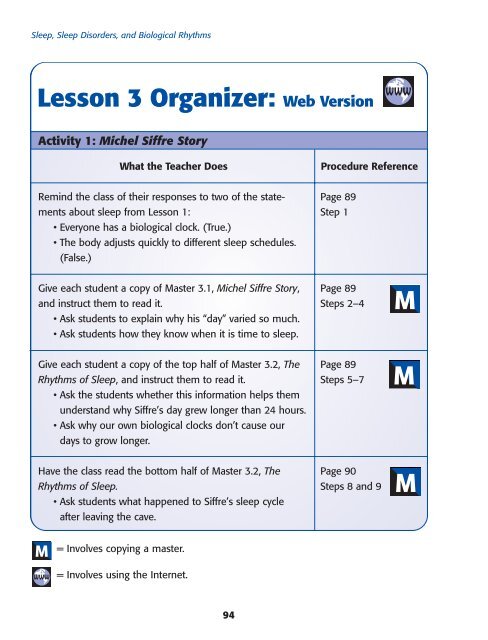Biological - NIH Office of Science Education - National Institutes of ...
Biological - NIH Office of Science Education - National Institutes of ...
Biological - NIH Office of Science Education - National Institutes of ...
You also want an ePaper? Increase the reach of your titles
YUMPU automatically turns print PDFs into web optimized ePapers that Google loves.
Sleep, Sleep Disorders, and <strong>Biological</strong> Rhythms<br />
Lesson 3 Organizer: Web Version<br />
Activity 1: Michel Siffre Story<br />
What the Teacher Does<br />
Procedure Reference<br />
Remind the class <strong>of</strong> their responses to two <strong>of</strong> the statements<br />
about sleep from Lesson 1:<br />
• Everyone has a biological clock. (True.)<br />
• The body adjusts quickly to different sleep schedules.<br />
(False.)<br />
Page 89<br />
Step 1<br />
Give each student a copy <strong>of</strong> Master 3.1, Michel Siffre Story,<br />
and instruct them to read it.<br />
• Ask students to explain why his “day” varied so much.<br />
• Ask students how they know when it is time to sleep.<br />
Page 89<br />
Steps 2–4<br />
Give each student a copy <strong>of</strong> the top half <strong>of</strong> Master 3.2, The<br />
Rhythms <strong>of</strong> Sleep, and instruct them to read it.<br />
• Ask the students whether this information helps them<br />
understand why Siffre’s day grew longer than 24 hours.<br />
• Ask why our own biological clocks don’t cause our<br />
days to grow longer.<br />
Page 89<br />
Steps 5–7<br />
Have the class read the bottom half <strong>of</strong> Master 3.2, The<br />
Rhythms <strong>of</strong> Sleep.<br />
• Ask students what happened to Siffre’s sleep cycle<br />
after leaving the cave.<br />
Page 90<br />
Steps 8 and 9<br />
= Involves copying a master.<br />
= Involves using the Internet.<br />
94

















